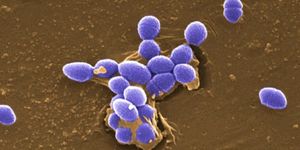How Spina Bifida Can Arise From Spontaneous Mutations
Spina bifida is a birth defect that happens when the spinal cord of a developing infant doesn't form correctly, because of problems in a structure called the neural tube. Folic acid is known to significantly reduce the occurrence of neural tube defects, though we don't know exactly why. Genetic mutations can cause neural tube defects, but these mutations are not always inherited; in some cases, they arise early on in development.
Some genetic mutations are passed down from parents to children because they've occurred in germ-line cells like sperm, which give rise to the whole body and are thus present in every cell. But some mutations occur after the initial stage of development but still early on, so these mutations will only be present in a portion of an organism's cells; these cause mosaicism.
Researchers have now used a mouse model to show that when a genetic mutation that is not inherited from either parent occurs in a gene called Vangl2, it can cause spina bifida when that mutation is found in 16 percent of the mouse's cells. This shows how a so-called mosaic mutation, which is not passed down from a parent, can cause spina bifida. The findings have been reported in Nature Communications.
Though folic acid supplements have reduced the occurance, about one in one thousand pregnancies are still affected by spina bifida. While there are surgeries that can correct the problem, we still have a lot to learn about why mosaic mutations happen and how environmental influences can cause them.
"Some environmental factors are known to increase the risk of these conditions occurring and very few affected individuals or their parents receive a meaningful genetic diagnosis. The discovery that mosaic mutations, which cause spina bifida, may not be inherited from either parent, and are not necessarily present in blood or saliva commonly used for genetic testing, may explain why," said study leader Dr. Gabriel Galea of the University College London Great Ormond Street Institute of Child Health.
In this work, the researchers began with a mutation in the Vangl2 gene that prevented the resulting protein from playing its normal role in a pathway that has a function in the directionality of cells. Mutations in this cellular pathway have been linked to spina bifida before this, and researchers have found Vangl2 mutations in about 15 percent of human fetuses with spina bifida.
The study indicated that when 16 percent of the cells in the developing spinal cord of a mouse carried the Vangl2 mutation, spina bifida happened. The authors suggested that this indicates how vulnerable these cells are to mosaic mutations affecting this pathway; they may not be easily able to make up for a bit of lost function, and the consequences can be devastating. Every cell that carries the Vangl2 mutation can stop six cells that are surrounding it from functioning, which dramatically amplifies the impact of these mutants.
"We found that the requirement for cells to talk to each other makes them exquisitely vulnerable to mutations in the signaling pathway that Vangl2 acts in," said Galea. "We now need to understand whether this vulnerability extends to other genes which could cause spina bifida. Detecting these mosaic mutations in living people will require technological advances and careful analysis of tissues resected during surgery."
Sources: AAAS/Eurekalert! via University College London, Nature Communications









